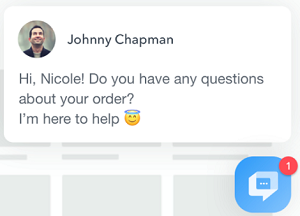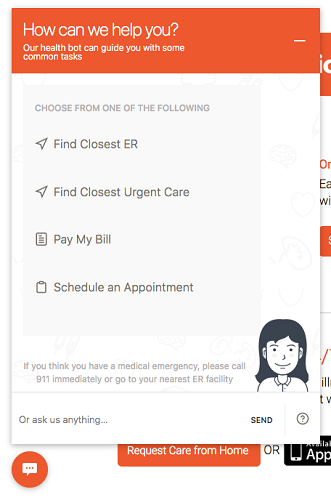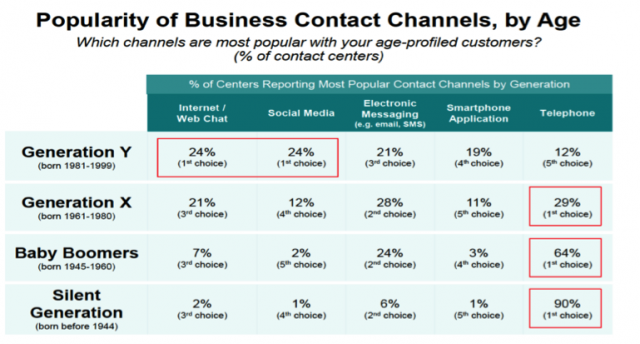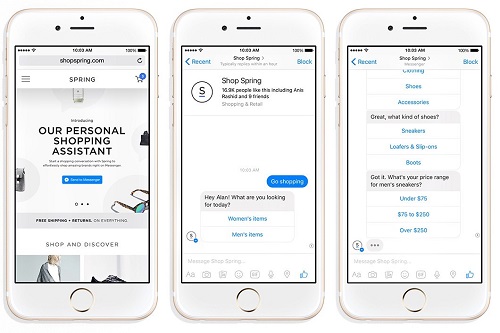Meet your soon-to-be new best friend, healthcare marketers: your website’s chatbot. Surprised? You shouldn’t be.
Chatbots are software widgets that can have natural conversations with humans. Building on recent breakthroughs in artificial intelligence, they’re coming on fast and may be commonplace sooner than we all imagine. If they live up to their promise, your hospital’s chatbot will one day work without complaint around the clock, deliver consistent and high quality customer service, gather valuable voice-of-the-customer data insights, and be your website visitors’ preferred communication channel. Your call center team will come to value its role, too.
Live, human-to-human chat has long been a popular website feature. Many of your site’s visitors—especially millennials and young boomers—greatly prefer live chats over traditional phone calls. Why? They view live chat as faster and more convenient. Multitasking while chatting is a bonus.
The benefits of live chat are many:
- For marketers, it’s much cheaper than a call center handling inbound phone calls; your operators can typically field 3-5 chats simultaneously versus a single phone call.
- For visitors, chat sessions are fast. Your operators can be armed with cut-and-paste answers to commonly asked questions like phone numbers and addresses.
- For SEO, chat transcripts are also a goldmine of voice-of-consumer insights for improving your website and overall patient experience.
The preference data’s quite compelling, suggests KPCB’s analyst Mary Meeker:
Unfortunately, live chat is not a panacea. It’s cheaper than your call center, but it’s still expensive. And it’s rarely 24×7. Operationally, it can be challenging to maintain a high level of service. Depending on training, quality levels can vary widely. And some people simply prefer not to engage with a person if they can avoid it.
Enter chatbots
Chatbots can converse with your site’s visitors, field basic (and maybe, one day, advanced) questions, and call out for human intervention when they need it. Despite sounding fantastical, chatbots in 2018 are real—even if somewhat limited in their capabilities.
Chatbots built on messaging platforms like Facebook Messenger, WhatsApp, Skype, WeChat, and Slack are definitely catching attention. There’s no new app to download, no new account to create, and, perhaps most importantly, no new user-interface to learn. These platforms have unbelievable reach and usage. The combined total monthly active user (MAU) count of the top 4 messaging apps exceeds 4.1 billion in 2018, with each of the top three messaging apps touting user bases of 1 billion or more. You’d be in good company on Facebook Messenger with a chatbot: the Wall Street Journal, KLM, Whole Foods, Amtrak, Uber, 1-800 Flowers, and thousands of other brands are already up and running. Consider Sephora’s chatbot, powered by Facebook Messenger:
Boston’s Drift also gets mentioned a fair amount, especially in business-to-business environments. Originally a website widget for live chat, they’re now using rules-based conversational tools that enable basic but nonetheless automated back-and-forth dialogues:
Chatbot barriers today
The promise of tomorrow’s chatbots gives us much to be excited about, but there’s a chasm between where we are today and our dreams of their potential. With a few exceptions, today’s chatbots are marginally helpful, easily confused, and far from conversational. “(Chatbots) certainly have very limited functionality,” Forrester Vice-President and Principal Analyst Julie Ask agreed in a recent interview with TechRepublic. “Most are hard-coded decision trees. Most need to escalate to humans very quickly to do anything more than answering a simple question,” she said.
The blocker between today’s rules-based, stilted reality and tomorrow’s dream of effortless, natural, and organic conversations? It’s enabling computers to understand human language and thought and then converse back with us. The problem’s an incredibly tough one given the complexity and nuances of the spoken word. Consider the difficulty of teaching an algorithm to differentiate between, “THEY would not let my dog stay in this hospital” vs. “I would not let my dog stay in this hospital.” The differences are subtle and hard to explain, even for native-born speakers.
Artificial intelligence—specifically “natural language processing” (NLP)—has made huge strides in the past 5-10 years. Our Siri, Cortana, Alexa, and Google digital voice assistants are proof of this progress. But, there’s a lot of work still to be done here. Try asking your favorite digital assistant a follow-on contextual question after an initial request; most will struggle. Puns, idioms, neologisms, and slang are also way out of reach. And don’t even think about broaching abstract topics!
What healthcare marketers should do in 2018
First, be brutally honest with yourself about what you’re looking to accomplish and how live chat or a chatbot will help your team and improve the user experience. Websites and their public-facing tools are highly visible so do your homework, have a strategy, and demonstrate ROI and other results. Mistakes will set you back unnecessarily.
Also, give some thought about the right place to field these inquiries. Is it on your website? Probably. But how about Facebook? That might dictate a different approach using Facebook Messenger. Some marketers are considering text-messaging options. Then, think hard about the user experience you’re trying to create. Are you looking to replace human-to-human communication? Co-exist with it? Or maybe augment it? Is this what your website visitors want?
Lastly, especially if your call center reports a lot of repetitive inquiries, explore a live chat widget like Drift for your website with your call center colleagues. Even as a pilot, this’ll give you a sense of your website users’ appetite for a new communication channel. You can also prove out the business care for further investment and iron out staffing, training, and other operational challenges.
Ready for more? There are more than a few commercial solutions leaning into the world of tomorrow’s AI-powered chatbots. Drift is one of them so you’d do well to follow their path. They’re making progress against the challenges of conversational chat and recently raised enough money to be seriously considered. Intercom’s also pretty interesting. Watch Facebook, too. Their current chatbots are accessed only from within the Facebook ecosystem, but they’re beta testing standalone widgets that can be deployed on third-party websites. Given Facebook’s consumer reach, access to data, and artificial intelligence resources, this could be a game changer.
What healthcare organizations are doing
At the recent Healthcare Marketing & Physician Strategies Summit (HMPS), Loyal and their client Piedmont Health demonstrated a HIPAA-compliant, healthcare-specific chatbot that the Atlanta-area system’s been using since the fall of 2017.
Accessed through a widget in the bottom corner of about a dozen pages across Piedmont’s website, Loyal’s friendly “health bot” is built on a custom neural net. It can field dozens and dozens of frequently-asked questions on topics ranging from paying a bill and locating care centers to finding a doctor and scheduling an appointment:
Prior to launch, Loyal and Piedmont worked together to identify the frequent questions that best lent themselves to being answered by the bot. Some topics like care center locations were intuitive. Piedmont’s call center staff added additional less obvious topics based on their hands-on experience. Website analytics data—especially site search query strings—also provided helpful clues.
Crafting thoughtful responses took time and care. Fortunately, Piedmont’s website already has content that addresses many of the more common inquiries. Repurposing this existing content was relatively fast and painless. Obscure topics were trickier. Asked about the availability of vegan food, the bot deduces that my question is related to the system’s cafeterias, asks me which care location I’ll be eating at, and then points me to site-specific website content related to guest amenities. In this case, the page ultimately didn’t address my question. Anticipating the format of questions that the bot would need to address was a priority. Confusing misspellings needed to be decoded. Abbreviations, too. Staff using the bot would bring their own terminology.
Lastly, the team wanted a graceful hand-off from the bot to a call center operator when the conversation wasn’t going anywhere. They intentionally erred on the side of a quick human hand-off to avoid unnecessarily frustrating a website visitor:
Coming up to 8 months post launch, Piedmont Health’s Chief Consumer Officer Matt Gove reports initial success: +16,000 conversations so far with over 3% of website visitors engaging with the bot on the pages that are live. Impressively, 80% of queries are fielded without needing a live operator to intervene. Gove also reports positive feedback from visitors about their bot experience. They appreciate how quickly they can get their questions addressed. Self-service tools are also quite empowering and thus more satisfying, he often hears.
Piedmont’s call center agents are apparently fans of the chatbot, too. They’re more efficient, often fielding 3-5 chats simultaneously through the live chat feature. Better, the bot’s ability to address basic and repetitive questions is freeing them to focus on more complex inquiries, a better use of their skills.
The bot’s log files also opened Gove’s eyes to questions he never imagined website visitors asking. Local hotel recommendations and instructions for ordering flowers were amongst these unexpected topics. Asked now, the Piedmont bot can offer help. My question about vegan food could one day be added if the team saw it being asked frequently.
Looking ahead, Loyal and Piedmont are looking to improve the quality of their answers with a simple “was this answer helpful?” query. This’ll help pinpoint topics needing more robust responses. They’re also looking to seamlessly integrate the bot with Piedmont’s online appointment scheduling system—a much preferred user experience and also a compelling way to prove the bot’s return on investment.
Chatbots, while still in their infancy, boldly promise to improve the user experience of website visitors while also delivering operational call center efficiencies. Should they be an urgent 2018 priority on your hospital’s website? Probably not. But should they be something you’re watching and planning for? Almost certainly.





